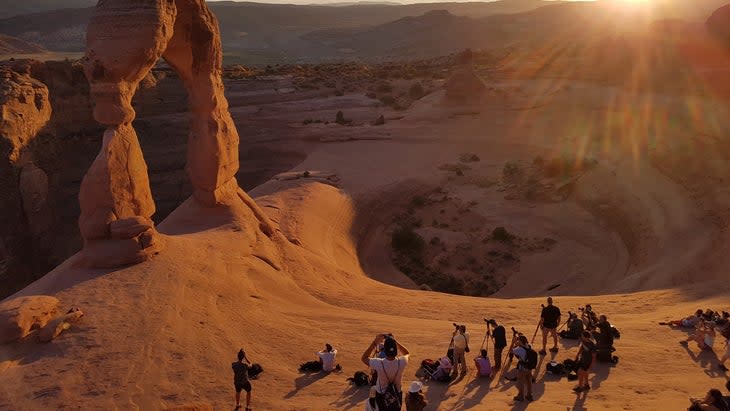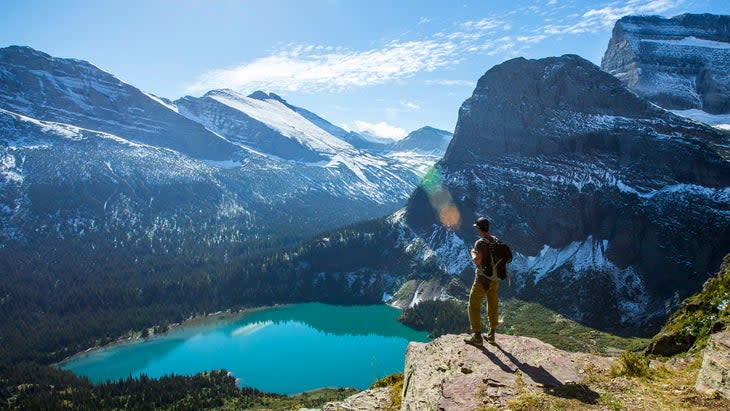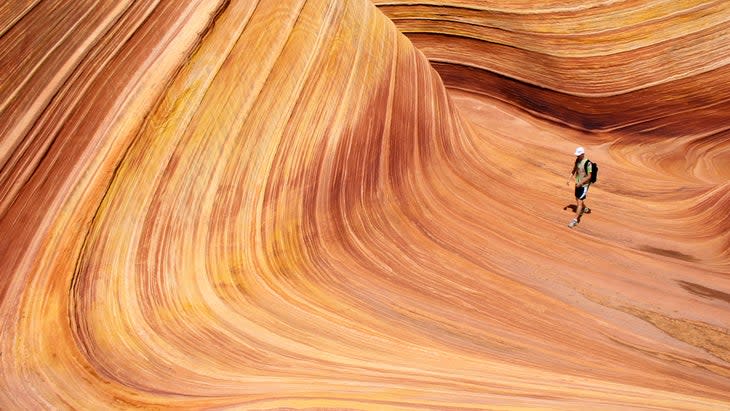You May Hate Recreation.gov. It Keeps Our Parks from Being Loved to Death.
This article originally appeared on Outside
Earlier this year, the Wall Street Journal dropped what an irate member of congress called a "bombshell report." The story focused on the government-commissioned booking website Recreation.gov and Booz Allen Hamilton, a private company the government contracted in 2016 to build, update, and manage the site and its 23 million active users.
The article came out hot and contrarian, as if the Journal was breaking news: "Visitors might assume," read the piece, "that, like entrance fees, the reservation charges help pay for improving trails...or expanding the park's volunteer program. But a chunk of the money ends up with consulting firm Booz Allen Hamilton Inc."
The story went on to detail that while Booz Allen's original contract estimate was $182 million over ten years, between 2018 and 2022 the company invoiced the government for $140 million, far exceeding the original estimates. The hook for the story was a lawsuit filed in January by seven outdoor enthusiasts who are going after Booz Allen for so-called "junk fees." The man-on-the-street interviews were feisty. '"It really galls me that my tax dollars are going to maintaining that public asset, but then somebody is privately profiting off of it," said Spencer Heinz, a 29-year-old mechanical engineer from Portland, Oregon, who uses Recreation.gov for backpacking permits.
So what's the deal? Is our government in cahoots with a private firm gouging the shit out of Griswoldian America? Should we be as galled as Spencer Heinz from Portland?
The short answer is no. The rec.gov website that was built and run by Booz Allen Hamilton is perhaps the most effective tool the government has for keeping public lands, especially National Parks, from being completely overrun by me, you, and everyone else. But keeping the rec.gov tool up and running and processing millions of transactions is hard--and beyond the capabilities of the government.

OK, let's dive into the weeds. First some background: if you haven't been paying attention, people are loving our public lands lately and Recreation.gov's numbers back that up. In 2019, 3.7 million folks logged onto the site to, among a range of other services, book RV campsites, river trips, backcountry access, or timed entrance permits. Sounds like a big number and it is. But for the website's last fiscal year (2022) that number jumped to 10.3 million. And those are just the people that actually booked. Today rec.gov services approximately 23 million active users--people who book reservations and those that just search for them--and works with 18 agencies, such as the National Park Service, Bureau of Land Management, Smithsonian Institution, and the Fish and Wildlife Service. Part of the booking spike is because more agencies are using the website than ever before, but visitation to parks is also up. There are simply more people out there loving beautiful places, as you have probably realized if you ever cast a fly into a hatch of drunk tubers.
In the most popular places, the crowding is more than the land and existing infrastructure can handle, and it's certainly more than our beleaguered public land managers can cope with, at least on the reservations front. It's been this way for a while, and way back in 1998 six federal agencies started sharing campground vacancy information on a portal called recreation.gov. The idea was to make life easier on both field managers and the public. In 2007 the website began taking reservations. Booz Allen is the second contractor to operate the site, and the company began building the latest version of it back in 2016.
Throughout their involvement, Booz Allen has reported to a government interagency management team called Recreation One Stop, which is the body that oversees Recreation.gov.
Anyway, in 2016 Booz Allen won a five-year contract to run the site, then the contract went year-to-year for five years. There were five other bidders for the contract. Booz Allen won with the lowest bid (estimate is a better word) and what the Recreation One Stop team thought were the best services. Another key point here: the $182 million budget came from Recreation One Stop's own revenue projections. It was based on a three to seven percent annual growth. Nobody foresaw the pandemic and the outdoor boom. The contract was of course challenged in court, but after much scrutiny, Recreation One Stop was successful in the U.S. Court of Appeals and Booz Allen was off and running. "We won at every stage because we did it right," says Rick DeLappe, interagency program manager for Recreation One Stop.
Here's how it all works at the field level. A manager at a National Park, Forest Service, BLM office, or the like decides that a user fee must be paid or that a site or trip is so popular that a paid permit or reservation is required to protect the resource and the experience. The consumer of those services--we the people--log into rec.gov and pay the designated fee or pay into a lottery to try to win a permit. That money goes to the Treasury Department. From that account, Recreation.gov pays Booz Allen for its work based off each transaction as agreed upon in the original contract, and almost all of the rest goes back to the individual agency. Over the past four years, says Delappe, 85 percent of what is charged goes back to the agencies. Recreation One Stop does not set those fees, nor does Booz Allen. But Booz Allen's original contract did include specific fees for various transactions. It's the managers in the field that set the prices. They of course try to cover their costs and the transaction costs for Recreation.gov.

It varies by agency, but you get the drift. Recreation One Stop and Booz Allen make all this possible behind the scenes. So, no misplaced funds there to speak of.
What the lawsuit and--by tone and tenor--the Wall Street Journal are objecting to, though, is a slightly newer dynamic that's grown out of that sharp uptick in popularity of our National Parks. I'll use Glacier National Park as an example because it's near my home, and it was the main example in the Journal.
Glacier's Going to the Sun Road was practically a parking lot when I drove my wife and visiting parents up it in the 1990s. With the Covid bump, the traffic became untenable--like getting out of Foxborough after a Patriots game. The park's fix was to follow Rocky Mountain National Park's lead and require reservations to drive the most popular roads. That way they could control the traffic. A reservation for Going to the Sun Road is good for three days. And again, the agents in the field set the price. You book those reservations through Recreation.gov.
The reservation system--in the parlance they're called Timed Entry Permits--immediately fixed the problem, and now people aren't stuck in traffic on a mountain pass waiting for a car-sized boulder from above to crush them. But as you might imagine, with traffic on Going to the Sun restricted, it steers more cares onto other park roads, so in a game of whack-a-mole, the administrators put the reservation system in place there too.
Now for more wonk 101. (Government!) The National Parks already charge people to get into a park. For Glacier that's $35 for a car full of humanity and all its cup holders. It's good for seven days. So for the additional timed-entry fees they charge $2. I have no way of proving this claim--what Booz Allen charges is undisclosed--but I'm guessing the fees (set by the agencies) are only covering what they are contracted to pay Booz Allen for the service. Oh, and yes, you read that correctly, the three day timed entry permit is two bucks. That's what the fuss is about.
I am not an apologist for privatizing anything when it comes to our public lands, but I'm not getting worked up about Booz Allen, Recreation.gov, and especially not these latest fees. Recreation.gov is a tool for the agencies, and Booz Allen is delivering that tool at a good value.
To get a second opinion on that I reached out to a web developer I've worked with. Rafael Romis is the founder and chief strategist of Weberous. His firm has built large e-commerce sites, and they’ve frequently been approached by state and city governments, but tend to turn down that work because the bureaucratic requirements are so daunting.
"From a web development perspective, 10 million bookings is an insane number," says Romis. To operate a site like that is no small undertaking, he says. It begins with the servers, which have to be some of the best available just to process that much information. "Think about how much data you have with 23 million active users. And then you need a team of senior developers, designers, and server administrators to keep it running. That's the 101 stuff, the hardware and the people. The second layer is security, which is huge. Ten million people plugging in their credit card information is not your typical Shopify site. Everything must be custom made. And then you have the final layer of making it accessible, which by law they must do…The thought of the government trying to do this is terrifying. It would be a disaster. [The site] would break down and it would always operate in the red. But with this site, while the design isn't great, they did an excellent job with the functionality. I'm clicking on things right now trying to see if they break and they don't."
For perspective, from my reporting, the government has never built and maintained a website of Recreation.gov's scale. A third party built the platform and then handed off the keys, but the third party still do the maintenance, support, and updating. Certainly anything of Recreation.gov's scale or bigger, tends to rely exclusively on trusted government contractors like Booz Allen, which delivered on more than 4,000 federal contracts in fiscal year 2021/2022. Much of Booz Allen's work is in defense and national security. Suffice it to say Recreation.gov is not their biggest project. Recreation One Stop's DeLappe was actually surprised that they bid on the outdoorsy work.
I'm personally glad they did. And I'm not alone. Especially now, with so much traffic. When Arches National Park went to a timed entry permit--previously, visitors were turning around on the sketchy two lane road or parking wherever and hiking off trail in the desert--users could rate their experience of the new timed entry system. Of 8,200 responses, more than 7,000 of them were four and five star reviews about their time in the park. Recreation.gov as a site also gets similar, overwhelmingly positive, feedback.
Meanwhile in the wonkiverse, the plaintiffs in the suit against Booz Allen are charging that a public review wasn't incorporated into the decision to charge for the timed entry permits. (Booz Allen's response is essentially that the plaintiffs need to bring that up with the agencies since they don't set fees.) Others, like Congressman Ryan Zinke of Montana have said that in requiring timed entry permits Glacier National Park is locking out locals and tourists and hurting gateway businesses; a charge that seems spurious when you consider how popular the parks have grown. (Zinke's office did not reply to emailed questions.) And then you have those who complain that their $2 isn't going to the park. We can’t definitively say, with that one, but again, we do know that over the past four years 85 percent of all fees did return to the land.

Let's get out of the weeds. Government runs off private partnerships. The biggest risk to our public lands is not nominal fees to keep the chaos at bay, the biggest risk is that we are the chaos. That's not true everywhere and on all of our open spaces, but our National Parks--the envy of the world--are endangered. We must use the tools we have to protect them. And one of those tools is rec.gov.
An example helps: the Wall Street Journal story included a photo of The Wave in Arizona and Utah's Vermillion Cliffs Wilderness. With its pelagic surrealism and extremely restricted visitation, the sandstone formation is perhaps the most sought after natural site in North America. But its fragility has long required that land managers meter the number of visitors. In modern times, you had to already be in the area to enter The Wave lottery. And to do that you had to show up at a stifling gymnasium and stand there watching ping pong balls in a spinning basket. This happened five days a week. "It's all the staff did all summer," says Recreation One Stop's Strategic Communications Lead Janelle Smith.
When the BLM asked rec.gov for help, the government interagency team and Booz Allen installed a virtual "geofence" in the area so that, in keeping with the policy, only people who made the trek could participate--which supports the local economy and ensures that no permits go to waste. Today, rec.gov delivers the lottery results to your phone when you're out hiking. The BLM received only one complaint about the new system. Every agency has a story about how many hours they're saving or the resources they’ve protected because of the tech tool. Rec.gov is also making camping better for a wider demographic of users. At its simplest, now you don't have to worry about finding a campsite after a long drive.
The lesson we should take from all of this? As massive as many of our National Parks are, the flora, fauna, and landscapes that they protect are not equipped to handle this new, smothering, trammeling, YouTubing us. The natural world is resilient when it's in balance, but it's as frail as sandstone under a hiking boot when it is not. Just like a great restaurant, a busy museum, or a concert, the wonders of the earth now require a reservation. Deal with it.
For exclusive access to all of our fitness, gear, adventure, and travel stories, plus discounts on trips, events, and gear, sign up for Outside+ today.

